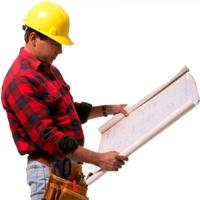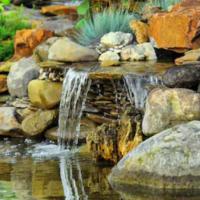How to Build a Waterfall
by Dan Eskelson on Apr 28, 2012
The number one, most asked question that I receive about water features is "How do I build a waterfall?"
The first advice I give is to visit natural waterfalls or at least look at photos. Don't try to memorize just how they look...just get a general idea of how the water flows around and over the rocks.
The design of your falls will depend on topography, pump and pipe size, length of water flow from the pump to falls, pond size, and possibly other site-specific factors. If your pond is just 4' x 6', you certainly don't want a large, three-foot-wide fall - keep the elements of your water feature in scale.
One of the most common mistakes results from the desire for a tall waterfall at a level building site...large amounts of soil are imported to build the falls up to a three or four-foot height. Yes, you will achieve a dramatic waterfall, but the total effect will look more like an out-of-place volcano. A fall of just two feet will produce a very satisfactory effect both visually and audibly.
On a level site, with an "average" size pond of 11' x 16', the amount of soil needed to surround the biological filter and create the berm is just about equal to the amount of soil excavated from the pond...it works out quite well. To further enhance or enlarge the berm, you may want to import a little more soil, large boulders, or other features.
If you are working on a slope, you have the option of placing the biological filter (waterfall source) uphill from the pond and creating a series of cascading waterfalls. This is how I built my falls
It was an exercise in visualization to determine exactly how the water would flow down the falls. I made a slight underestimation of the total flow and could have widened the falls somewhat, but the effect is very acceptable.
Even on a level site, it's a good design strategy to place the falls six to eight feet from the pond. This will create a short stream to the pond.
Be sure to use a wide EPDM rubber liner under the falls and/or stream...this will allow for twists and turns in the course of the water and also contain splashing. a ten-foot-wide streamliner is recommended. Underlayment under the falls and streamliners is usually not required.
When your excavation is complete for the falls, and the liner is in place, add your stone. Don't be in a hurry - try several (or many) combinations and visualize how the water will flow.
When satisfied with your arrangement, use black waterfall foam to direct the water over the stone instead of under it. That is, stone that is directly in contact with the liner should sit on a bed of foam so the water goes around or over the stone instead of underneath it. Caution - the foam expands greatly...don't use too much!
Though it requires some creativity and patience, building a waterfall is extremely satisfying. Though you should give some time to preliminary research, you'll learn most by actually building your water feature - just do it! You'll find that your water garden is the most relaxing and enjoyable part of your yard.
Popular Articles
Three Places to Spend Money on the Exterior of Your Home
When you have the exterior of your home remodeled, you are investing, time, energy and convenience into the project and you want to make sure that...
104838 Views
Homemade Headboards-Make an Upholstered or Wooden Headboard
Homemade headboards can add a lot of personality to any bedroom. They can be coordinated with existing furniture and room decor or they can be the...
80108 Views
When to Use a Brush, Roller or Sponge Brush
Brushes are a good choice for painting trim and woodwork. They are also useful for cutting in the edges around the top and bottom edges and corners...
72769 Views
Creating a Cottage Kitchen with Bead Board
Kitchen decor can range from modern and bold to elegant and elaborate by using strategic kitchen pieces. One of the most popular decorating trends...
58535 Views
Gas Fireplace Diagnostics and Troubleshooting
Follow these steps for diagnosing and troubleshooting Gas Fireplaces repairs. For the average DIYer, this may seem intimidating, depending on the...
35575 Views
Latest Articles
How Much Does it Cost to Take a Bath?
Plumbers know that a bath may seem like a relaxing luxury, but the real cost extends far beyond your water bill. The average soak uses 35 to 50...
on Apr 8, 2025
10 Concrete Patio Ideas on a Budget
A concrete patio can be a game-changer for your outdoor space. It is durable, versatile, and can be customized to fit your style. But what if you...
on Mar 25, 2025
Tips for Creating a Stunning Personalized Photo on Canvas
Order the unique beauty of a personalized photo on canvas and bring your memories to life. With a customized photo on canvas, you can transform...
on Mar 7, 2025
Best Areas to Buy Property in Singapore for Long-Term Growth
Singapore's real estate market remains one of the most stable and lucrative in the world. With limited land supply, strong governmental...
on Feb 18, 2025
Troubleshooting Excess Water in Your HVAC Secondary Condensate Drain Pan
When maintaining your air conditioning system, it is easy to overlook the condensate drain pan - until excess water starts pooling in places where...
on Jan 12, 2025
Featured Articles
What Type of Licensed Contractor Should You Hire?
on Feb 28, 2017
Hire Contractors / Estimates

Looking for a specialty project? There are many types of contractors available for your home improvement needs. Finding the right type of...
Sponsored Articles
Best Areas to Buy Property in Singapore for Long-Term Growth
on Feb 18, 2025
Real Estate / Finance

Singapore's real estate market remains one of the most stable and lucrative in the world. With limited land supply, strong governmental...
Actions
Top Categories
- Garden / Landscaping / Patio — 264
- Kitchen / Bathrooms — 240
- Real Estate / Finance — 203
- Appliance / Repair — 186
- Interior Design / Decor — 184
- HVAC / Air Conditioning — 148
- Cleaning / Maintenance — 144
- Improvements / Remodeling — 131
- Plumbing / Basements — 118
- Floors / Tile / Hardwood — 116
- Doors / Garages — 113
- Safety / Security — 113
Articles Archive
More DIY Articles
6 Favored Methods for Foundation Waterproofing You Should Know
If you have ever walked down to your basement and noticed a small trickle of water or a small puddle on the floor, you may dismiss it as no big...
Start Getting Your Home Ready for Spring with These Four Tips
Winter is finally starting to wind down. For many of us, Winter meant cold temperatures, rough weather, and a lot of time spent inside. When Spring...
5 Reasons You Should Have Granite Countertops in Your Kitchen
We all want to have beautiful bathrooms and kitchens with recessed lightning, honey glazed cherry or maple cabinets, stainless steel appliances and...
Residential andCommercial HVAC Service: What’s the Difference
HVAC denotes heating, ventilation, and air conditioning. HVAC systems assist in regulating the environmental temperatures and humidity while...
Hawaii Local Builders Associations
Find a local builder or council, please contact the home builders' association (HBA) in your area.

